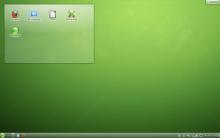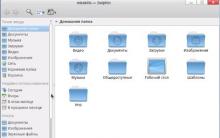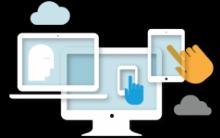Every Windows user knows that, regardless of the program, right-clicking can call up an additional, so-called context menu, which contains a set of special commands and links. Let's try to figure out what it is for and how to work with it correctly.
What is the Windows context menu
Speaking about the context menu of "OSes" of the Windows family, I immediately want to note the fact that it is not some kind of exclusive development of Microsoft Corporation. Mac OS X or Linux also has this element.
In general, if you understand what a context menu is, it can be described as an additional set of commands for quick access to any functions, say, without calling a specific application or control.

So, for example, everyone knows that the context menu always contains the "Open with ..." command, after which a list of the most suitable applications for working with the file is displayed. You yourself understand how much more convenient it is to open a file here than to call the program, and then go to the "File" menu and use the "Open" line or the keyboard shortcut Ctrl + O.
In addition, in addition to commands, there is also a set of special tools with which you can learn many things. But more on that later.
View and organization of the context menu
Let us now consider how the Windows 7 context menu is organized. Probably, everyone paid attention to the fact that the menu itself contains special separators in the form of thin horizontal lines. The meaning of their use is to distinguish between actions of the same type or commands belonging to one program.
Here it is worth paying attention to the fact that the context menu in a “clean” system, so to speak, immediately after installation, can be very different from what the user sees after installing additional programs and utilities. This is due to the fact that many installation packages integrate commands for quick access to some of their main functions directly into this menu during the installation process.

Most of all, this applies to anti-virus software, media players, programs for working with disk images, archivers, etc. In principle, the user can add his own items to ensure the convenience of work.
Additional menu on the desktop and in program windows
Surely, each user noticed that the context menu in different programs or on the same desktop differs in the list of items and commands. It is natural. For example, if you call up the menu on the desktop, it becomes clear that the “Open” line used for folders and files is not needed there. Another thing is when the mouse button is clicked on a shortcut or a saved file located on the desktop.

As it is already clear, in different programs the context menu can also contain dissimilar items. In this case, it all depends on the specifics of the application. Compare at least the usual Explorer and the text editor Word. But for now, we will focus on the "native" commands of the Windows OS.
Basic context menu items
Dropdown menus are present almost everywhere, even in the main Start menu. In any of them you can see some items marked with arrows. This is done to show that the clause itself contains additional subclauses.

As usual, for files and folders at the very top, there is always an “Open” command in bold. When you click on this line in relation to files, they will be opened in any program. You need to know that selection occurs only if the application itself sets the association of the file with this particular program. Otherwise, using this command will only result in the system prompting you to browse and select the most appropriate application. If several programs are associated with the file, you can use the "Open with ..." line, which will contain a list of programs that work with the extension of the file you are looking for.
It goes without saying that in the context menu of the same Explorer there are commands like "Copy", "Delete", "Cut", "Paste", "Send", "Rename", "Create Shortcut", etc. Even a child knows this. On the other hand, there is also a "Properties" line, the use of which provides the user with complete information about the object being used.
So, for example, when calling such a command by clicking on the computer icon on the desktop, you can get general information about the main parameters of the computer system and the installed operating system. For the desktop, the context menu provides basically only the use of settings and options for synchronizing folders with sharing attributes.
Some menus also provide administration or inspection tools for selected items.
Using Additional Context Menu Commands
Now let's talk about some additional commands. If you give an example of an installed antivirus, you will notice that the context menu will always contain lines like "Scan" or "Check with ...". Agree, very convenient.

The same applies to archivers, because you can add a file (folder) to an archive or extract it from there with one click.
Many media players behave in a similar way, integrating their own commands into the system's context menu. Most often, for multimedia files, the items for adding to a playlist or playing (video and audio) appear here, and for graphics, this is a view command. In general, it all depends on what kind of program integrates its own command lines into the menu, and what objects are associated with it.
Adding and removing commands in the system registry
So we got to solving the problem - how to add your own items to the context menu. This can be done in several ways. In this case, at least three options can be proposed. Two of them concern editing the system registry, and one concerns the use of specialized utilities.
In the system registry, you can use the addition of keys, but if you don’t know which keys and their values are responsible for a particular process, you can spend a lot of time, achieve nothing in the end, and bring the system to a state of complete inoperability.
Therefore, consider the simplest way to work with the registry. First, the command to access the regedit editor is used in the Run menu. Here you need to go to the HKEY_CLASSES_ROOT section, find AllFilesystemObjects, then shellex and finally ContextMenuHandlers.

In the last section, an additional menu is selected by clicking the right mouse button and the command for creating a new object and the key "New" and "Key" is executed, respectively. Now you need to enter a name for the newly created key, which will be displayed in the context menu, after which we select the "Change" command and in the overview indicate the location of the program or application that will be responsible for the new action. Confirm the selection and reboot the system.
Deleting the keys in this section will cause the corresponding command from the menu to disappear. But if you do not know which key is responsible for what, it is better not to change the standard configuration.
Using the Context Menu Tuner
However, as practice shows, no one really wants to rummage through the registry (you never know what can happen). Therefore, we can recommend special utilities for adding and removing items to the OS context menu.

One of the simplest, but very functional, is a utility called Context Menu Tuner. It will help you quickly change the menu beyond recognition. Everything is simple here. The main window includes two panels. Commands are located on the left, folders and main parameters are on the right. As it is already clear, there is nothing easier than choosing the desired command and using the button to add it, say, to the desktop menu. Removal is done in reverse.
Separately, it is worth noting some additional options. First, you can select some file extension, and only then associate the appropriate command and program with it.
Changing the context menu access button
By default, the context menu button is the right mouse button. It is very easy to swap buttons and call the context menu with a left click. To do this, you need to go to the mouse settings in the Control Panel and perform the necessary manipulations. Only and everything.
Explorer's context menu is the menu that appears when you click RMB (Right Mouse Button) on some object (file or folder) or just on an empty space in a folder or Desktop. If your system is new, then the context menu will be relatively empty. Is that just added from the drivers for the video card, for example like this:
but if the system has been installed for a long time, then there will be more such points. For example like this:

As you can see, over time, in addition to the standard menu items, more from installed programs were added. On the one hand, it's convenient. After all, you do not need to launch a shortcut or search for a program, but you can directly perform actions immediately from the context menu. But on the other hand, over time, there are a lot of such items, and sometimes the context menu even has to be scrolled up or down in search of the necessary items.
Therefore, sometimes you want to remove these items so as not to interfere. After all, you do not use all the points often.
So how remove item from context menu.
In order to remove a program item from the context menu (KM for short), you can use both the standard methods of the Operating System itself, and using the programs themselves or specially designed ones.
The easiest thing to remove is to look in the settings of the program (which you want to remove) for the desired item. It is usually located somewhere in Integrations or Upload/Add. For example, in order to remove the item of the famous WinRAR from KM, you need to uncheck Shell integrations:

Other programs may also have similar settings.
Another thing is when you did not find the necessary settings for deletion or they do not exist at all (it happens sometimes). Then you can use the standard method of the systems itself, namely editing.
I warn you right away that before starting work it would be better to play it safe and make a backup copy of the registry.
So, we launch the registry and go to the branch
HKEY_CLASSES_ROOT/*/shellexe/ContextMenuHandlers

and see here these same items from the context menu.
Now we right-click on the desired item (the item from the CM that you want to delete) and select Delete:

We agree with the following warning:

reboot and check. The point should be gone.
If not gone, then look at the branch
HKEY_CLASSES_ROOT\AllFileSystemObjects\ShellEx\ContextMenuHandlers
and do the same.
On a note:
If you want to delete an item specifically from CM -> Create

then you need to know the type of file () that is being created. For example, for Microsoft Office Access, the file extension is .accdb, which means you need to look for it in the HKEY_CLASSES_ROOT registry branch, and delete the ShellNew subsection there

If you want to remove from the KM those items that appear when you RMB on folders, then you need to look at the branches:
HKEY_CLASSES_ROOT\Directory\shell
HKEY_CLASSES_ROOT\Directory\shellex\ContextMenuHandlers
HKEY_CLASSES_ROOT\Folder\shell
HKEY_CLASSES_ROOT\Folder\shellex\ContextMenuHandlers

For the "Open with ..." item, the branch answers
HKEY_CLASSES_ROOT\*\OpenWithList
For KM Logical Disks branches:
HKEY_CLASSES_ROOT\Drive\shell
HKEY_CLASSES_ROOT\Drive\shellex\ContextMenuHandlers

You can also delete items using special programs. For example using ShellExView

Its principle is simple: select the desired item and click on the red circle at the top of the program. The main thing here is to Type was Context menu

Now a little about how create your own item in the context menu.
The fact is that adding such an item for folders or certain files, as well as on an "empty" place using the registry, will not work. You can only assign it to when it opens with RMB on the Desktop. Therefore, I recommend reading the article and using what is described there.
Well, or use another utility - Ultimate Windows Context Menu Customizer() which has a bunch of features, but in English. And there we only need to select the item and delete it:

If you are interested in more details and do not understand, then write in the comments and I will help. There, in the left column, you need to select the item (computer, folder, files, etc.) where the context menu is called, and to the right, select what to delete and click the Remove Item button at the bottom. If you are friends with English, then you will understand.
You can guess how to add your program to KM -> Create if you carefully read the entire article, namely about deleting one of this item. You just need to create a subsection on the contrary and write for the desired extension.
In general, the article turned out to be a little chaotic and more about removing from the context menu, because. I think that this is more relevant, and there is an article about adding. Therefore, if something is not clear - write in the comments. Let's figure it out.
Good day, dear friends, readers and other personalities. Today, as you understood from the title, we will talk about the menu right mouse button, i.e. the context menu, or rather, let's clean it up, edit it and add it.
The fact is that over the lifetime of your computer and, more precisely, as you install and remove various kinds of programs, the menu already mentioned turns into a uniform mess.
This happens especially often when you do not follow all the checkboxes when installing software (although not always these checkboxes are even given to you to choose) and are generally irresponsible about your own system (and this happens, yes).
In general, let's get to the point.
Introductory. How does it happen
Well, I think that it is probably not necessary to show the harsh minimum of what the context menu can turn into. Or show it? It usually looks something like this:

Cute, huh? This is exactly what we will fight against, because most likely you don’t use and don’t plan to use half of what is shown above in the screenshot, but finding the right item in the right-click menu becomes difficult and time-consuming.
Download the program Easy Context Menu
None other than the Easy Context Menu program will help us edit all this mess, as, in fact, I hope you understand from the subtitle (and the title of this) article. The program is completely free, supports the Russian language and so on.

Then it's up to the small thing - to edit all the horror that you have in this very menu of the right mouse button. The program allows you to remove or add elements, so you can both clean it up and litter it even more.
How to use the program and enable the Russian language
Having launched the program, we will see its main window, which looks approximately as follows:

In case the Russian language did not decide to appear on its own, then simply open " Options -> Languages -> English"and the program will happily work in Russian.

The program itself is extremely simple. See the mouse icons from left to right? They are what we need:

They are responsible for (again, from left to right):
- Apply changes if you have edited something with checkmarks in the paragraphs below;
- Cancel changes if you have edited something with checkmarks in the paragraphs below;
- Editor of the list of available commands for the right-click menu;
- Cleaning the context menu;
- Information about the program.
Within the framework of this article, we are interested in the item with cleaning. You can deal with the rest yourself, since there is nothing complicated in this.
Clearing the right-click menu
Actually, we click on the mouse with a whisk, after which we get a completely visual table with your current list of context menus, as well as names, registry keys (yes, you can do this not with a program, but through the registry), the place where this right-click menu item comes out with other information.

Actually, here you can deactivate or activate the necessary items, delete them altogether, go to the desired registry section, and so on. In simple terms, by managing the local checkboxes, you can remove everything that you don’t use, and just add the necessary ones in the main program window (which you may have dreamed about for a long time or vice versa, in fact, you didn’t even suspect).
As a result, you can get this (or even much smaller) nice context menu:

Which is already much less than it was in the terrible screenshot above, although it is not yet ideal, because the points that the author of the article personally needs are left here.

Well, how and what to add (and there is clearly something to add, since there are enough interesting points), I think you will figure it out, since this is done from the main program window and is no more difficult than deleting something - just check the boxes and apply the changes.
Afterword
Here are the things. Now you can always keep your right-click menu (context menu) under control with the help of such a simple and wonderful program.
As always, if you have any questions, thoughts, additions, and so on, then welcome to the comments on this article.
Thank you for being with us.
Add an item to the context menu of windows 10 explorer for convenient and quick launch of programs we use frequently. Quickly launch the desired applications without shortcuts. Let's look at 2 options: context menu, create cascade popup.
Incorrect operation of the registry will lead to a system crash. All actions are done at your own peril and risk. You can use the video instruction by clicking .

Let's add items to the context menu of Windows 10 Explorer.
Let's start the registry editor. Press "start", the line "search", enter.

We launched the editor, now we follow the path:

Now we create a name to reflect in our menu. In my situation, the Smite toy:
- We press "RMB" - the right mouse button on the line shell.
- Create.
- Chapter.

I made the name of the toy "smite".

We make a command to launch the toy:
- We press RMB on the section made, in the presented case, "wash away".
- Create.
- Chapter.

We set the command to the created key. Create a section, write a name " command".

Now copy the path of the toy. In my case "E:\smite\smite.exe".
- We chose the executable (.exe) file of the game, program.
- Press Shift + Right click on smite.exe, " copy as path". Only when you press a combination of buttons will this line appear.

Set the copied path to the registry. Select our team from the left" command" with a mouse click. From the right in the field, click quickly 2 times to open the window:
- 1. Select a section
- 2. Open the "options" window
- 3. Put the mouse slider in the value line
- 4. Press "RMB" paste

It should turn out something like this. The "value" column should contain the executable path to the program.

- 1. Select the created section from the left in the column.
- 2. Click on the empty field to the right Create.
- 3.String parameter.
- 4. Set a name icon, designate the path to the location of the toy.

It should work. Icon, title.
Creating a cascading menu with items.
I really like this method. You can easily sort everything beneficial for using at the computer. Create sections "game", "programs", "graphics", place 3-9 applications each. Having dealt with a simple method, how to add an item to the context menu, It will be easier for you to understand the essence of the pop-up cascade. A complex procedure that requires attention. We will work with two registry keys.
Create a cascading menu. We go into the registry: "start", drive in the word "regedit" in the "search". I'm on my way:
HKEY_CLASSES_ROOT\Directory\Background\shell
- Click "RMB" on the folder shell.
- Create section.
- Come up with a name. I wrote menu 101.

We make in "menu 101" string parameters with the names of the names of the four keys:
- MUIVerb(name to reflect).
- SubCommands(reflection of names).
- icon(reflection of the picture).
- position(position: above, below).
I want to clarify what is in the key SubCommands you need to separate the toys " ; " (smite; Tomb Raider).

A visual representation of the set values:
- Asked icon. (assigned the path to one of the games, exe file, automatically sets the icon).
- position in the contextual scoreboard, did not exhibit, you can write " Top"-above, " bottom"-bottom.
- SubCommands name names that we wrote with ";" (smite;Tomb Raider). The picture shows the icons in front of the name of the toys. We will ask them further. You should get it like here, only without the icons of the games.
- The display name that was written in the value MUIVerb.
In the picture you will not have half. Just an explanatory example of which option will be displayed. There are a few more steps to be taken.

Created four files. Now we register the label functionality. Until then, only Game with picture. For reflection, as shown in point three (picture above). Let's go to the following registry key along the path:
HKEY_LOCAL_MACHINE\SOFTWARE\Microsoft\Windows\CurrentVersion\Explorer\CommandStore\Shell
- Right-click on the shell folder, create the partitions that were set in SubCommands(smite;Tomb Raider). It should turn out from the left in the column there are two folders with names.

Created two of our folders. After these two partitions are created, the windows will cascade, but will not function.

We set the default value with the names of the games to display in the pop-up window:
- 1. Select the section with the toy from the left.
- 2. Click twice on the line.
- 3. In the window that opens, write the name of the game that belongs to the folder on the left. (In the smite folder, the value is smite. Tomb Raider, the value is Tomb Raider).

We create icons opposite the game names. Create in smite, Tomb Raider String parameters With name icon, specified by the path to the exe file. Let me remind you to copy the path. Press Shift + right click on smite.exe, " copy as path". . Create a string parameter, specify the path to the game. Do not forget to write the name icon.
![]()
Now we set the launch of the command so that they function, run. Create a section in each folder (smite, Tomb Raider) named command.

- We allocate command.
- We press 2 times.
- We indicate the path of our toy.

.
In this lesson, we will take a closer look at the functions of a very useful key that is on any keyboard. This key is called the "Context menu key". It is located in the lower right part of the keyboard between the ALT and CTRL keys.
When this key is pressed, the CONTEXT MENU is called up, exactly the same as if you pressed the RIGHT mouse button.
The feature of this button is that the menu called when you click will display functions (menu items) that can be applied in the current program, in the active window, on the desktop, etc. Those. this menu adapts to the process in which you are directly working, and this is very convenient.
Now let's take a closer look at the main options for displaying the context menu in different environments and the functions that can be performed using this menu.
1. Pressing the RIGHT mouse button or the "Context menu" key on the Windows desktop
For Windows 7
When you press the RIGHT mouse button or the "Context Menu" key on the Windows 7 desktop, a menu of the following form appears:
1. At the very top of the menu - setting parameters your video card.
2.View- setting the display of icons on the desktop
3. Sorting- setting sorting by displaying icons on the desktop
4. Refresh- updating the display of content on the desktop.
5.Insert- if you copied something, you can paste it on your desktop.
6. Create. Here you can create on the Desktop: a folder, a shortcut, a text document, an archive, MS Office documents - Word, Excel, PowerPoint, etc. (if installed)
7. Screen resolution. Here you can set the necessary screen settings: select a screen (there may be several), find out or set the screen resolution, determine the screen orientation, and also configure other screen settings, for example, connect a projector.
8. Gadgets- selection and installation of Windows 7 gadgets. There is no such function in Windows XP.
9. Personalization. Here you can customize the appearance of the Desktop, change the background, splash screen, sounds, theme, window color, etc.
For Windows XP
In Windows XP, as many of course know, the context menu looks simpler, but performs almost the same functions.
When you press the RIGHT mouse button or the "Context Menu" key on the Windows XP desktop, a menu of the following type appears:
1. Using the first menu item Arrange icons we can perform the following operations:
Screen resolution configured on the tab Parameters
2. Pressing the RIGHT mouse button or the "Context menu" key on a file or folder in Explorer or any other file manager.
When you press the RIGHT mouse button or the "Context Menu" key on a file in Explorer or any other file manager, the menu is also adjusted to a file of a certain type. For example, I clicked by video file. The following menu opens:
In this case, the menu offers functions that correspond specifically to the video file: play, add to the list of the player that is selected by default for this file type. And a number of standard functions: open with, add to archive (if an archiver is installed), send, cut, copy, delete, rename and file properties.
If you click the RIGHT mouse button or the "Context menu" button on a graphic file, then a menu will open that will correspond to the graphic file type:
Here you can immediately open, edit or print the selected file in the default image program. In my case, this is the ACDSee program.
Here you can immediately make the selected file a background image for the Desktop, very convenient when choosing from a large list. And then there are again the standard functions for working with files.
In Windows XP, there are no special differences,
standard functions for working with a file are called by the command Change
I will dwell in more detail on the points “Open with” and “Send”.
Benefits of the "Open with" feature
Here you can select or assign any installed program that understands the selected file format to work with the selected file. In this case, I clicked on a video file and several programs can work with this format on my computer: Light Allow, WinAmp and, of course, Windows Media Player.
If the list does not contain the desired program, but you know for sure that it is installed, select the menu item "Select program". Windows will prompt you to select programs from a list of recommended or other programs.
In Windows XP, the appearance of this window is slightly different, but the meaning is the same:
If you want the selected file format to always be opened by the program you choose, then check the box "Use the selected program for all files of this type".
If the desired program is not in the list of recommended programs or in others, but you know for sure that the program is installed, then press the button "Overview…" and select it from the folder where the program is installed.
What is the use of the "Submit" function
Using this function, you can send (transfer, transfer) the selected file via BlueTooth (bluetooth), skype, mail, to the desktop, to the archive, to write to a CD / DVD disc, to a flash drive etc.
3. Pressing the RIGHT mouse button or the "Context menu" key in any Internet browser.
And here, too, the menu adapts to different situations, depending on where you click on the web page. For example, if you click link, then the following menu will open:
With this menu, you can open the contents of the link in a new tab or window, bookmark the link, send the link, copy the link, if the link is a file, then you can save it with "Save Target As...". If you have download programs installed, you can download the contents of the link with their help.
If you click the RIGHT mouse button or the "Context menu" key by image on web page, then a menu with other functions will open:
Here you can copy the image to the clipboard and paste it, for example, into a Word document, you can save the image to your computer using "Save Image As ...", send the image by mail, make the selected image the desktop background, find out information about the image (type, size, file name), etc.
Let me summarize. In this lesson, we looked at the most popular options for using the context menu, which is invoked by clicking the RIGHT mouse button or pressing the "Context Menu" key on the keyboard.
Namely:
1. Pressing the RIGHT mouse button or the "Context menu" key on the Windows desktop
2. Pressing the RIGHT mouse button or the "Context menu" key on a file or folder in Explorer or any other file manager.
3. Pressing the RIGHT mouse button or the "Context menu" key in any Internet browser.
The essence of this lesson is to learn how to use the useful features of the specific active environment of your computer. In any environment, by clicking the RIGHT mouse button or by pressing the "Context Menu" button, you will receive a list of useful functions available at a given time, relative to the selected object.











Personal account of the insured person
Automatic identification system Joint use of AIS with an electronic chart system
Wargame: Red Dragon not starting?
Sad escobar "The face of the judicial system of Ukraine"
ROME Total War - how to unlock all factions?